Morphology of Roots
The root is the underground part of a plant that anchors it to the soil and absorbs water and minerals for its growth and survival. Roots perform essential functions such as providing structural support, storing food, and sometimes even playing a role in reproduction. Let’s dive into the regions of roots, root zones, and the types of root systems, along with their functions.
Regions of the Root
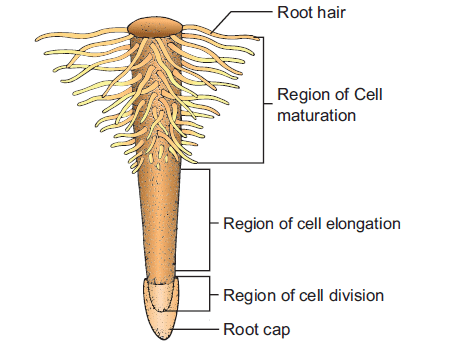 >
>The root can be divided into several regions, each performing specific functions related to growth and absorption. These regions are as follows:
- Root Cap:
- The root cap is a protective structure that covers the tip of the root. It is made up of several layers of cells that secrete mucilage to help the root penetrate the soil. The root cap also protects the meristematic tissues behind it as the root grows deeper into the soil.
- Region of Cell Division (Meristematic Zone):
- Just behind the root cap is the meristematic region, where active cell division occurs. This region is responsible for the root’s growth in length. Cells in this zone are small, with large nuclei and thin walls.
- Region of Elongation:
- In this region, newly formed cells from the meristematic zone elongate and increase in size. The elongation of cells pushes the root deeper into the soil. This is the zone responsible for most of the root’s growth in length.
- Region of Maturation (Differentiation Zone):
- Cells in this region mature and differentiate into specialized tissues such as xylem, phloem, and cortex. Root hairs are also present in this region, increasing the surface area for absorption.
- Root Hairs Zone:
- This zone is crucial for the absorption of water and minerals from the soil. Root hairs are tiny hair-like extensions that come out from the epidermis and provide a large surface area for efficient absorption.
Root Zones
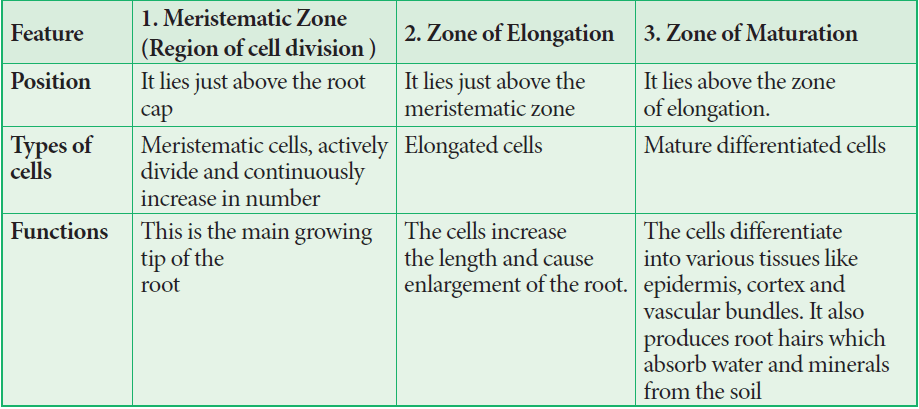 >
>The root is divided into four major zones based on function:
- Root Cap Zone:
- Protects the growing tip of the root from injury as it moves through the soil.
- Meristematic Zone:
- Actively dividing cells are found here, contributing to root growth.
- Elongation Zone:
- Cells in this zone increase in length, driving the root deeper into the soil.
- Maturation Zone:
- Cells differentiate into various specialized tissues, and root hairs emerge to absorb water and nutrients.
Types of Root Systems
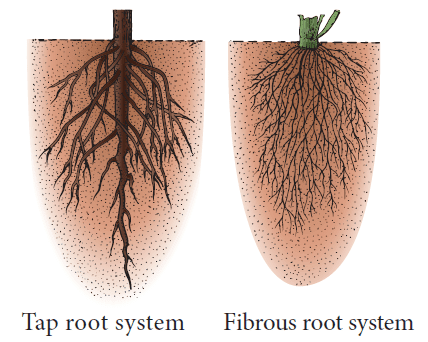 >
>Roots can be classified into two major types based on their origin and structure:
1. Taproot System
- Definition: The taproot system consists of a primary root that grows directly from the radicle (embryonic root). This main root grows deep into the soil and gives rise to lateral (branch) roots.
- Examples: Carrot, beetroot, radish, and dandelion.
Functions of the Taproot System:
- Anchorage: The taproot system provides strong anchorage, allowing plants to grow tall and stable in the soil.
- Storage: In some plants (like carrots and radishes), the taproot stores food in the form of starch, making it an essential part of the plant’s metabolism.
- Deep Water Absorption: Taproots can penetrate deep into the soil to absorb water and nutrients from deeper layers, especially in arid conditions.
2. Fibrous Root System
- Definition: In the fibrous root system, the primary root is short-lived, and it is replaced by numerous fine roots that spread horizontally just below the soil surface. These roots are thin and thread-like.
- Examples: Grasses, wheat, rice, and maize.
Functions of the Fibrous Root System:
- Prevention of Soil Erosion: The fibrous root system forms a dense network of roots near the soil surface, which holds the soil particles together and prevents erosion.
- Efficient Absorption: Fibrous roots are highly efficient in absorbing water and nutrients from the upper layers of the soil.
- Shallow Anchorage: While they provide excellent support for grasses and small plants, fibrous roots do not penetrate deep into the soil, making them suitable for plants that rely on surface water.
3. Adventitious Root System
- Definition: Adventitious roots arise from any part of the plant other than the radicle or its derivatives. They may develop from the stem, leaves, or other plant parts, often in response to environmental conditions.
- Examples: Banyan tree (prop roots), maize (stilt roots), and mangroves (pneumatophores).
Functions of the Adventitious Root System:
- Support and Anchorage: Adventitious roots like prop roots (e.g., in banyan trees) and stilt roots (e.g., in maize) provide additional support to plants.
- Specialized Adaptations: Some adventitious roots serve specialized functions, such as respiration in waterlogged soils (pneumatophores in mangroves) or storage of food (e.g., sweet potatoes).
- Vegetative Propagation: In some plants, adventitious roots help in vegetative propagation, allowing new plants to grow from cuttings or detached stems.
Types of Roots with Specific Functions
- Prop Roots:
- Found in plants like the banyan tree, prop roots grow down from horizontal branches to provide additional support. These roots give extra stability to large trees.
- Stilt Roots:
- In plants like maize and sugarcane, stilt roots arise from lower nodes of the stem and enter the soil, providing support against strong winds.
- Pneumatophores:
- Found in mangroves, these specialized roots grow upwards from the soil to help the plant “breathe” in oxygen-poor environments. Pneumatophores allow gas exchange in waterlogged conditions.
- Storage Roots:
- Some roots, such as those of carrots, beetroots, and sweet potatoes, store food in the form of starch or other carbohydrates. These roots swell to accommodate the stored nutrients, which can be used during times of need.
- Aerial Roots:
- In some plants like orchids and banyan trees, aerial roots grow above the ground and absorb moisture from the air. These roots are often adapted to humid environments.
Morphology of Roots: Root Modifications and Their Functions
Roots are crucial for plant survival, performing essential roles like anchorage, absorption of nutrients and water, storage of food, and specialized functions like respiration and mechanical support. Over time, roots have evolved to develop various modifications to adapt to different environments and serve specific functions. In this blog post, we will discuss root modifications, including taproot and adventitious root modifications, and their respective subtypes.
Root Modifications
Root modifications refer to the structural changes in roots that allow plants to adapt to their environment. These modifications help in storage, breathing, mechanical support, and other vital functions.
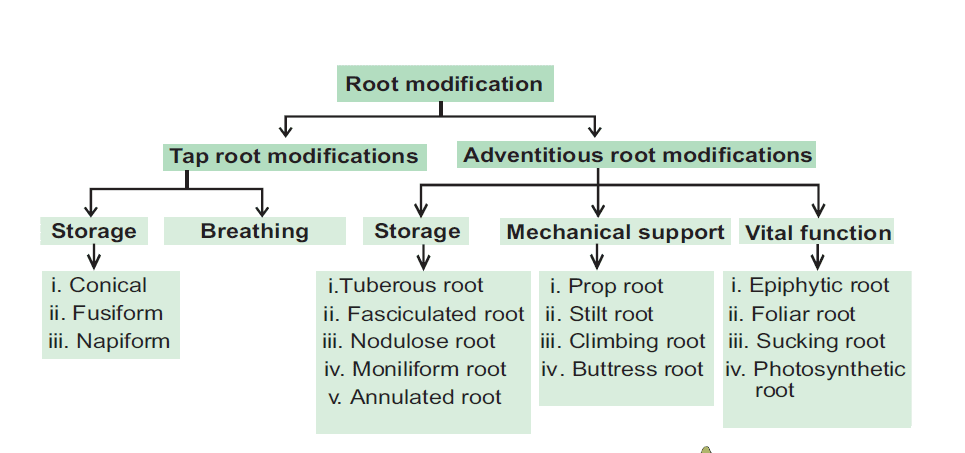 >
>1. Taproot Modifications
Taproots arise directly from the radicle (embryonic root) and grow deep into the soil. Taproot modifications are primarily seen in dicots and can be divided into two categories based on their functions.
A. Storage
In many plants, taproots are modified to store food in the form of carbohydrates. There are three main types of storage roots:
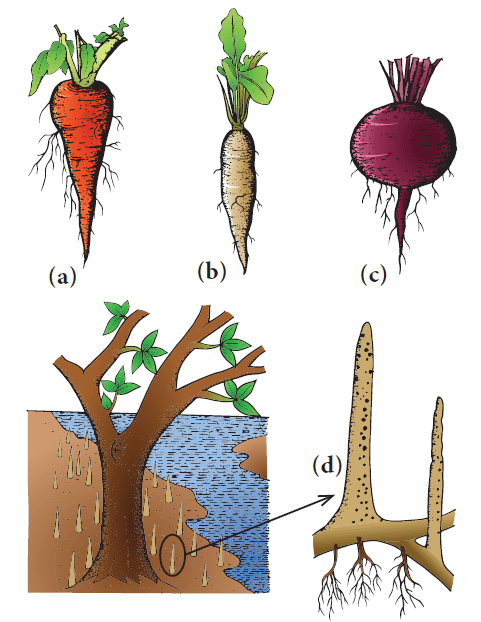 >
>- Conical Root: The root is wider at the top and tapers gradually toward the bottom.
Example: Carrot. - Fusiform Root: The root is spindle-shaped, wider in the middle and tapering towards both ends.
Example: Radish. - Napiform Root: The root is spherical at the top and tapers sharply towards the bottom.
Example: Turnip, beetroot.
B. Breathing
Certain taproots, especially in waterlogged conditions, are modified to facilitate gaseous exchange. These roots have special structures called pneumatophores, allowing oxygen to reach the plant in oxygen-poor environments.
2. Adventitious Root Modifications
Adventitious roots arise from any part of the plant other than the radicle, such as the stem or leaves. These roots have evolved to perform specialized roles like storage, mechanical support, and vital functions.
A. Storage
Adventitious roots also serve as storage organs, accumulating nutrients and food for later use. There are several types:
- Tuberous Root: Thickened roots without a regular shape that store food.
Example: Sweet potato. - Fasciculated Root: Clustered roots that arise in bundles and serve as storage organs.
Example: Dahlia. - Nodulose Root: Roots swell at their tips to store nutrients.
Example: Ginger. - Moniliform Root: Roots that look like beads, with swelling at regular intervals.
Example: Bitter gourd. - Annulated Root: Roots have ring-like structures formed due to the deposition of food.
Example: Ipecac.
B. Mechanical Support
Some adventitious roots are modified to provide additional support to plants, especially those growing in unstable or loose soils.
- Prop Root: These roots grow from the branches of a plant and penetrate the soil, providing mechanical support.
Example: Banyan tree. - Stilt Root: These roots arise from the lower nodes of the stem and provide support in plants growing in windy or marshy areas.
Example: Sugarcane, maize. - Climbing Root: These roots help plants cling to surfaces and climb, providing stability in the process.
Example: Ivy. - Buttress Root: These roots extend outward from the trunk of large trees, providing extra stability in shallow soil.
Example: Fig tree.
C. Vital Functions
Some adventitious roots are specialized to perform additional functions like photosynthesis or helping plants thrive in specific environments.
Photosynthetic Root: These roots are green and carry out photosynthesis, supplying the plant with food.
Example: Tinospora.
Epiphytic Root: Found in epiphytes, these roots help absorb moisture from the air.
Example: Orchids.
Foliar Root: These roots grow from leaves and help in vegetative propagation.
Example: Bryophyllum.
Sucking Root (Haustoria): These parasitic roots penetrate the host plant’s tissues to absorb nutrients.
Example: Cuscuta (dodder plant).